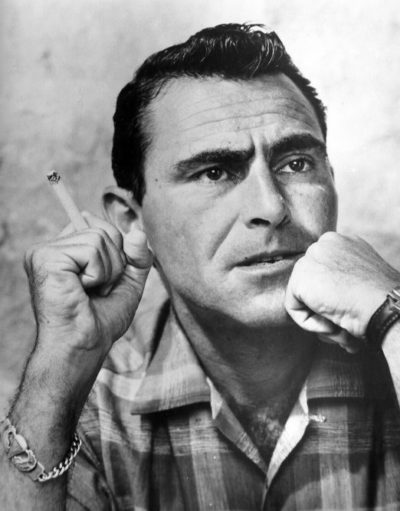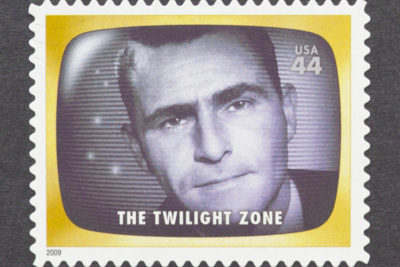6 Reasons The Twilight Zone Is the Greatest Series in TV History
Rod Serling saw things differently. As a television writer, he tried to broach controversial subjects and social issues, but frequently found himself at odds with networks and sponsors. He ultimately reasoned that he could tell more stories of the kind that he wanted if he cloaked them in the veneer of science-fiction and the supernatural. Since the best horror, fantasy, and science fiction stories comment on the human condition anyway, his notion made a perfect fit. This week in 1959, Serling brought The Twilight Zone to television. The anthology series made a deep impression on the American psyche during its four seasons, deep enough that the show has been turned into a theatrical film and revived for new runs in three separate subsequent decades. For its 60th anniversary, here are six reasons that The Twilight Zone remains one of the greatest, and most important, series in the history of television.
1. The Theme
We recently placed the spoken-word intro of The Twilight Zone at number one on our list of classic show-openers, and with good reason. There’s never been a more effective scene-setter than Serling’s ever-evolving narrations and Marius Constant’s eerie tune. The second season intro is perhaps the most famous, with Serling intoning, “You’re traveling through another dimension, a dimension not only of sight and sound but of mind; a journey into a wondrous land whose boundaries are that of imagination. That’s the signpost up ahead—your next stop, the Twilight Zone.”
2. The Writers and Directors
The assembly of talent behind the various iterations of The Twilight Zone remains impressive. For the original four-season series, Serling, a decorated World War II veteran who used the G.I. Bill to gain an education in literature and broadcasting, wrote or adapted a whopping 99 of the 156 episodes. Among the other writers were masters of horror and science fiction like Richard Matheson (16 episodes), Charles Beaumont (19 episodes), and that old friend of The Post, Ray Bradbury. The directors came from film and television, frequently boasting hefty resumes or bright futures; among them were names like John Brahm (director of film classics like The Lodger), Stuart Rosenberg (Cool Hand Luke), and Christian Nyby (The Thing from Another World). That tradition of top-flight talent continued into the later reboots of the series, with writers like Harlan Ellison and directors like Jordan Peele (Get Out), who runs the current version seen streaming on CBS All Access.

3. The Actors
The list of actors who graced individual episodes of the original series reads like a Who’s Who of Hollywood. Some were young and unknown, while others were well-established at the time. We’re talking about Ron Howard, Carol Burnett, Robert Duvall, Charles Bronson, Dennis Hopper, William Shatner, Burgess Meredith, Cloris Leachman, Elizabeth Montgomery, Robert Redford, Burt Reynolds, Julie Newmar, Art Carney, Mickey Rooney, and Buster Keaton, among many, many others. That tradition continues today, with established talents like Tracy Morgan and Seth Rogen appearing alongside newer stars like Zazie Beetz.
4. The Twists
Despite its prodigious reputation in this regard, not every episode of The Twilight Zone deployed a shocking twist ending. However, those that did produced some incredibly memorable conclusions, which helped build that reputation for the show. Endings that are still discussed and debated today include the final scenes of “To Serve Man,” “Time Enough at Last,” “Eye of the Beholder,” and “The Monsters Are Due on Maple Street.” Those four episodes, plus two others and a Serling retrospective, are coming to select movie theaters in November.

5. The Indelible Images
In addition to the trippy and spooky sights of the opening, the show worked off of a strongly cinematic visual vocabulary. While “To Serve Man” is most famous for the climactic explanation of its title, the suspense that is built into the last few scenes is expertly delivered (even as it works in a sight gag involving a smiling alien and a scale). The tight shots in “Nightmare at 20,000 Feet” put the viewer in the same claustrophobic space that William Shatner’s character is experiencing. That high-level craftsmanship, combined with the impact of the stories themselves, left a lasting impression on generations of viewers.
6. The Truth
Perhaps the most important element of The Twilight Zone is that each episode turns on an essential truth about humanity. People can be prideful or judgmental, but that comes with a cost. Awareness is good, but paranoia is destructive. Not all gifts are given with the best intentions, and so on. Serling’s aim was also true; he wanted to tell particular kinds of tales wrapped in a package that made them inviting to the masses. It’s easy to say that he succeeded. Unfortunately, some of the things that Serling and the other writers tried to warn us about still exist in American culture. People are still suspicious of their neighbors. Differences are not always celebrated. And we’re frequently more concerned about what we’ve got than helping our neighbors. Maybe that’s why the show keeps coming back; every generation needs to learn its lesson. That’s just a little bit of introspection, courtesy of The Twilight Zone.
Featured image: Photo 12 / Alamy Stock Photo.